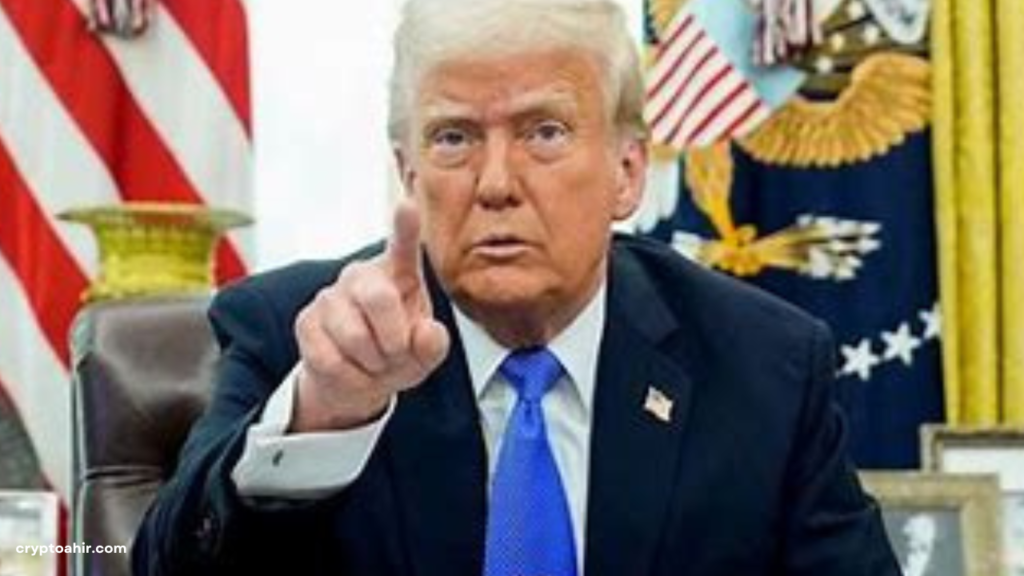The cryptocurrency market is becoming more volatile as the US gets ready to impose fresh tariffs. More market instability might result from recent events involving South Korea, Japan, and China.
The three nations have decided to react to the tariffs collectively, which raises concerns about how the cryptocurrency market may be impacted by tensions in global commerce. The future of Bitcoin and other cryptocurrencies is uncertain due to President Trump’s anticipated “Liberation Day” tariffs.

US Tariffs and Tensions in International Trade
According to reports, South Korea, Japan, and China have all pledged to work together to solve the impending U.S. tariffs in early April. Among the many industries targeted by the levies are the pharmaceutical and automobile industries. This action follows US threats to apply further tariffs on Wednesday, April 2, which President Donald Trump has dubbed “Liberation Day.”
Furthermore, these tariffs may have an impact on the stability of the economies of these three countries, which are significant trading partners of the United States. This kind of collaboration shows that they have forged strategic partnerships to protect their export markets and financial benefits.
Following a meeting of the three nations’ trade ministers, the declaration was made in an effort to strengthen cooperation and lessen the impact of US policies. However, the likelihood of a trade war still hangs over the cryptocurrency market, and emotions over the trade problem might further worsen.
Due in large part to the growing integration of the national and international business arenas, particularly in the cryptocurrency sector, these changes have prompted alarms over a number of international financial markets.
*Teenagers are making millions by launching viral memecoins—why not you? 🚀 Take advantage of this trend and create your own token today with XXX, the most trusted platform for effortless success! – https://launchtoken.fun/?ref=1
Analysis of Bitcoin Prices Amid Concerns About Tariffs
Already, there are indications of trouble in the cryptocurrency industry, with Bitcoin seeing a sharp drop. Bitcoin was trading at $82,687 on March 31, down over 2% in a day. A negative trend has been maintained by the cryptocurrency’s most recent decline, which follows a string of lower lows. The market has reacted warily to news about the state of the world economy, and Bitcoin’s price has found it difficult to sustain its pace.
All things considered, the US market’s activity is a major factor in the decline in the price of bitcoin. With the US approaching “Liberation Day” on April 2, when fresh tariffs are expected to be imposed, traders are bracing for more volatility in the cryptocurrency market. These elements include the prospects for international commerce and the ambiguity surrounding what the
With traders lowering their exposure to more risky assets, the recent price action of bitcoin reflects a larger risk-off mentality. After dropping for four days in a row, Bitcoin managed to rebound a little, but the general mood is still pessimistic. Key resistance levels have not been overcome by Bitcoin, and there is still a good chance that it will continue to decline.

Institutional Interest and Prospects for the Future
Institutional interest in Bitcoin is still high despite the cryptocurrency’s recent price drops. According to Glassnode’s analysis of on-chain data, the number of addresses holding between 1000 and 10,000 Bitcoin has also been gradually increasing, suggesting that institutional investors are still involved in the market.
This purchase by institutional investors demonstrates that, even in the face of temporary declines, investors are growing their long-term Bitcoin holdings.
The prevailing bearishness of the cryptocurrency market has also caused XRP, Cardano (ADA), Solana (SOL), Dogecoin (DOGE), and Ethereum (ETH) to decrease.
Furthermore, Bitcoin exchange-traded funds (ETFs) have seen consistent inflows, indicating that institutional traders continue to have a need for Bitcoin. Large investors’ continued interest stands in stark contrast to the market’s overall risk-off attitude. Analysts are still wary, though, since tariffs and economic uncertainties may limit Bitcoin’s price in the near future.
The Price Resistance of Bitcoin in the Event of a Crypto Market Decline Continue
The price of bitcoin has reached significant resistance and support levels, which experts like Rekt Capital also view as critical. Bitcoin is currently trading just above the $82000 mark. The upside’s immediate goal
The price of Bitcoin could, however, find it difficult to hold steady if the tariffs cause more economic uncertainty. If the market stabilizes, some analysts predict that Bitcoin may return in a V-shape.
However, if the negative trend persists, the price of bitcoin may experience more drops, possibly reaching lower support levels near $70,000 or even below, contingent on how the market responds to the tariffs and tensions in international commerce.








